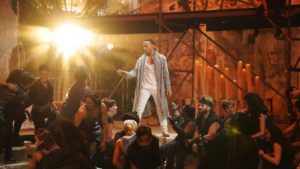In preparation for my new research project on the Old English Exodus, I’ve been reading the poem in its original language and in a variety of translations; I’ve also been reading its source text, the book of Exodus from the Hebrew Bible. I’ve known for a while that I would turn next to this poem, as I think it can inform and be informed by this particular cultural moment, when many Americans are having difficult but essential conversations about race, ethnicity, immigration, and nationhood. For me, the text’s original appeal was the brief mention of the Afrisc meowle at its very end (l.580) – the gold-adorned African woman who celebrates the triumph of the Israelites as they cross the Red Sea out of slavery towards the promised land. I think she is the only woman of color in the Old English poetic corpus.
Here’s an image of that text from the manuscript (Oxford, Bodleian Library MS Junius 11, f.171):
![]()
A transcription of the text in question (starting from the second word):
afrisc meowle on geofones staðe gol
de geweorðod
Which translates into Modern English as “the African woman, on the water’s shore, with gold adorned.”
Most commentators on this part of the poem identify this woman as Moses’s Ethiopian wife, who is understood exegetically to represent the “Church gathered out of the nations.”1 Whatever her patristic meaning, she is also the only individual woman mentioned explicitly in this poem focused on battle, armies, tribes, and miracles.
Her participation in the celebration constrasts her with the most famous meowle in Old English poetry, the geatisc meowle (Geatish woman) who mourns at the funeral pyre at the end of Beowulf (l.3150). Both of them, however, are distinguished as a single woman in a group, separated from the group lexically if not logistically. The meowle in Beowulf is surrounded by her people, the Geats for whom she predicts sorrow and defeat in the near future.
In Exodus, the afrisc meowle is eð-fynde (easy to find) within the group of celebrating Israelites – perhaps because of her gold ornaments, but more likely because of her physical difference from the Israelites, the phenotype of her skin color. The meowle of Exodus is in the group but not entirely part of it – she is differentiated as Afrisc rather than included as one of the Israhelum (Israelites) even as she sings and collects treasure with them. Her marriage with the leader of the group, the celebrated hero and law-giver, is not enough for her to completely assimilate into the folc or the Isrehela cynn (terms the poet uses to refer to the Hebrews following Moses). Even alliance with the most powerful of patriarchs cannot fully integrate her into the group.
Marked as Other by her gender, her skin color, and her geographical origin, this easy-to-find woman has begun to represent for me the deep history of tensions in cultural assimilations and exclusions. Twentieth-century critics focused almost entirely on her exegetical meaning, allegorizing the actual meowle out of their interpretation of the poem. It’s time to refocus critical attention on her and her place in the text.
More updates to follow throughout the summer as I deepen my lexical and literary investigations into the Old English Exodus…..
- Fred Robinson, “Notes on the Old English Exodus” Anglia 80 (1962): 363-378, at 376.


